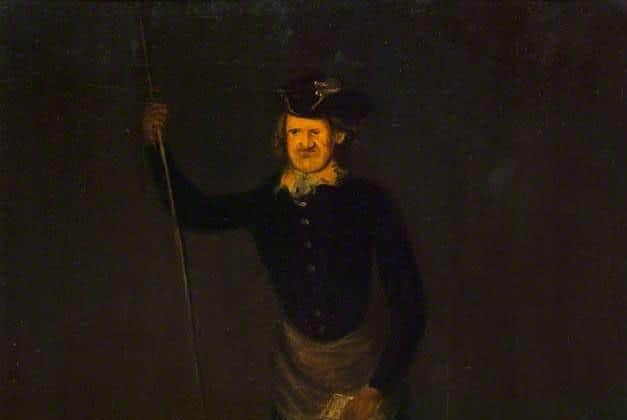How 'chapmen' and 'flying stationers' told the news to Scotland for centuries – Susan Morrison
Rolling news pours into our homes today. We watch politicians resign and kings crowned in live time. If we get mildly bored by the drum horses or weepy apologies, we can always do a little online shopping without even leaving our seats. Very modern, and yet, very old. We’ve been simultaneously keeping up with fashions and keeping up-to-date for longer than you’d think, although not quite with the same level of convenience. We had to wait until the world chapped the door.
Long before 24-hour news channels, Amazon and DPD, there was the ‘chapman’, the itinerant seller who travelled Scotland with not just luxuries like buttons and ribbons, but also news and stories from around the country, perhaps even the world. They were a sort of slow-moving human podcast, with merch. They got their name from the books they sold, printed on cheap paper, known as “Chap’’ books. Literate Scotland couldn’t get enough of them.
Advertisement
Hide AdAdvertisement
Hide AdAt usually less than 30 pages long, they were more a pamphlet than a book. You could buy tales of derring-do, romance, comedy and history. There were ‘how-to’ manuals, covering skills such as treating minor injuries in farm animals and life-coaching for young people, with titles such as “How Good Boys and Girls, By attending to the Rules contained in this Book, and obeying their Parents and Guardians, may acquire Wisdom, Riches, and Honour”. Rather suspect that one was bought by the parents rather than the children.
Given Scotland's deeply religious nature, low-cost bibles and inspirational works were sure-fire best sellers. John McTurk, chapman of Chanlockfoot had “Isaac Ambrose Looking to Jesus” and “A Margin'd Bible” in his stock when he died in 1780.
The arrival of the newsman with his wares was an event in a small Highland village, or a remote big house. Needles, thread and the latest big spiritual thinking were on the shopping list, but if you wanted the really hot gossip, and the latest ballad tunes, you got the chapman a warm fireside seat, a good meal and a drop of something convivial. One family whipped up a syllabub, which involved grated nutmeg, pounded lump sugar, half a bottle of port wine, some Madeira, sherry or possibly brandy. A cow was then milked on top of the mixture, which created a sort of frosting or delicate crust. It was usually served outdoors. Presumably that’s where the cow was.
Cup filled, you could retreat to the fire and hear the low down on the big city goings-on, whilst considering the purchase of a bright ribbon or some shiny buttons, all carefully laid out by the chapman like an ambitious Tupperware lady. The drink probably helped sales. Come on, who hasn’t bought a bit of bling whilst mildly squiffy?
These travelling salesmen have left little trace on the records. We know the names of very few. There was Hugh Gare in Huntly who sold bonnets, handkerchiefs and spectacles as well as those books and pamphlets. In 1779, Levi Pollock, a Jewish chapman, died and his inventory included buckles, watches and "some Hebrew and High German Books”.


Some chapmen took more of an interest in taking the news to the people. They called themselves “flying stationers”, and one of the most famous of these was Charles Leslie, born in either 1676 or 77 in Aberdeenshire. He was a bit wobbly on the exact date.
In today’s world of sharp-suited 24/7 news desk anchormen, Charlie might not have passed the audition. A contemporary described him as a “remarkably thin made man, about five feet ten inches high, small and fiery eyes, a long chin, reddish hair”. His portrait, which you can see on the National Galleries’ website, shows a man with a round face, and a distinctly pouty wee lip. This gave him the nickname, “Mussel Mouthed Charlie”, or as he was better known, “Mussel Mou'd Charlie”.
His beat was the East Coast, often around Aberdeen. He was the boy for the top news of the day. When he knew of a hanging in Edinburgh, he made sure to be at the scaffold to catch the last words of the condemned, to be repeated up in the North East of Scotland for the delectation of the company. He wrote his own stuff, too, and would perform his own ballads and verse, much of which was political. Being a Jacobite in a time of Hanovarians, that tended to get him into trouble.
Advertisement
Hide AdAdvertisement
Hide AdIn the great tradition of political journalists, Charlie managed to get himself banged up by the magistrates of Aberdeen fairly regularly. They finally got fed up with him loudly singing and selling Jacobite songs and, it is recorded, they asked: “What for he did it?”
“Why, says Charlie, for a bit of bread. Why, says the Provost, cannot you sing other songs than that rebellious ones? Ay, says Charlie, but they winna buy them.” Clearly, a man who knew his audience and what they liked to hear.
This really was a man who walked 500 miles and then 500 more, indeed thousands. He regularly walked from Edinburgh to Fraserburgh. Google Maps says you do that in 59 hours today, but in 17th/18th century Scotland, Charlie wouldn’t have had the benefit of the A90. Or the Forth and Tay Bridges.
Ten thousand steps a day was just a pre-breakfast stroll for Mussel Mou'd Charlie, which may go some way to explain his thinness. It might also explain his fitness, since Charlie died in 1782, which made him 105 when his travels came to an end. Not the flying stationers though. They stayed in business for decades after his death, carrying the latest news through the glens, along with a bit of ribbon and a set of fine buckles.
Comments
Want to join the conversation? Please or to comment on this article.
